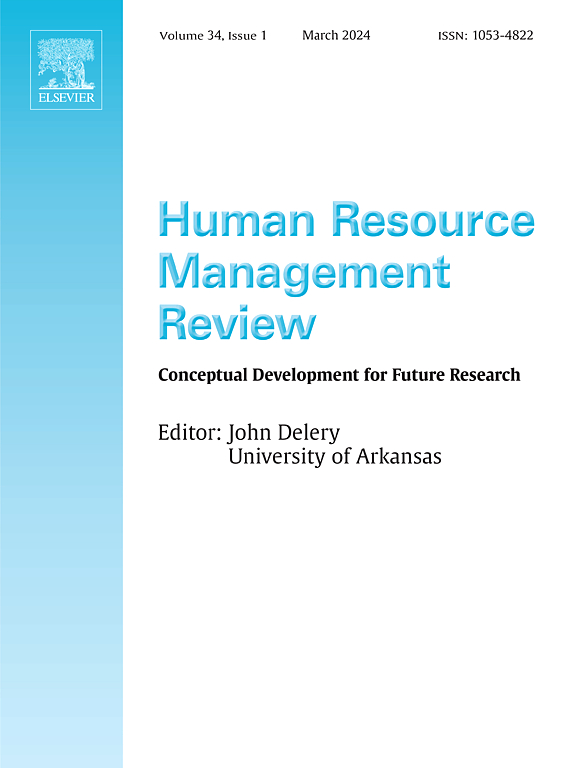A review of text analysis in human resource management research: Methodological diversity, constructs identified, and validation best practices
IF 13
1区 管理学
Q1 MANAGEMENT
引用次数: 0
Abstract
Discovering and producing reliable and valid measures of psychological constructs are central aims for human resource management (HRM) researchers and practitioners. While HRM researchers have historically relied on traditional quantitative methods, increased accessibility of text analysis techniques enabled by advancements in machine learning make qualitative data more convenient to analyze and include in decision-making processes. In this review, we systematically analyze research in HRM, organizational behavior, strategy, and entrepreneurship that has used text analysis to uncover and/or measure constructs. Our goals are to 1) delineate types of text analyses (categorization, dictionaries, supervised machine learning, and unsupervised machine learning), 2) review what constructs can be derived from text data, 3) describe how those constructs have contributed to the core HRM functions, 4) provide guidance on validation efforts that are needed to trust inferences made, and 5) and identify future research opportunities to use text analysis by HRM function. We support these points by conducting two text analyses on the papers in our review: a hand-coded content analysis using an existing framework and building a topic model of the abstracts. We find that while there is convergence (triangulation), there is notable divergence such that the topic model revealed more nuanced and useful clustering in significantly less time, thus illustrating the value of different types of text analysis. We encourage HRM researchers and practitioners to use machine learning to increase efficiency, reduce subjectivity, increase replicability, and facilitate methodological diversity. We close with a brief discussion on the promise of large language models.
回顾人力资源管理研究中的文本分析:方法多样性,结构确定,并验证最佳实践
发现和产生可靠和有效的心理构念测量是人力资源管理研究者和实践者的中心目标。虽然人力资源管理研究人员历来依赖于传统的定量方法,但由于机器学习的进步,文本分析技术的可访问性增加,使得定性数据更便于分析并纳入决策过程。在这篇综述中,我们系统地分析了人力资源管理、组织行为、战略和企业家精神方面的研究,这些研究使用文本分析来揭示和/或测量结构。我们的目标是1)描述文本分析的类型(分类、字典、监督机器学习和无监督机器学习),2)回顾可以从文本数据中导出的结构,3)描述这些结构如何对核心人力资源管理功能做出贡献,4)为信任所做推断所需的验证工作提供指导,5)并确定未来的研究机会通过人力资源管理功能使用文本分析。我们通过对我们综述中的论文进行两种文本分析来支持这些观点:使用现有框架进行手工编码的内容分析,并建立摘要的主题模型。我们发现,虽然有收敛(三角剖分),但也有显著的分歧,使得主题模型在更短的时间内揭示了更细微和有用的聚类,从而说明了不同类型文本分析的价值。我们鼓励人力资源管理研究人员和实践者使用机器学习来提高效率,减少主观性,增加可复制性,并促进方法的多样性。最后,我们简要讨论了大型语言模型的前景。
本文章由计算机程序翻译,如有差异,请以英文原文为准。
求助全文
约1分钟内获得全文
求助全文
来源期刊

Human Resource Management Review
MANAGEMENT-
CiteScore
20.20
自引率
7.00%
发文量
0
审稿时长
48 days
期刊介绍:
The Human Resource Management Review (HRMR) is a quarterly academic journal dedicated to publishing scholarly conceptual and theoretical articles in the field of human resource management and related disciplines such as industrial/organizational psychology, human capital, labor relations, and organizational behavior. HRMR encourages manuscripts that address micro-, macro-, or multi-level phenomena concerning the function and processes of human resource management. The journal publishes articles that offer fresh insights to inspire future theory development and empirical research. Critical evaluations of existing concepts, theories, models, and frameworks are also encouraged, as well as quantitative meta-analytical reviews that contribute to conceptual and theoretical understanding.
Subject areas appropriate for HRMR include (but are not limited to) Strategic Human Resource Management, International Human Resource Management, the nature and role of the human resource function in organizations, any specific Human Resource function or activity (e.g., Job Analysis, Job Design, Workforce Planning, Recruitment, Selection and Placement, Performance and Talent Management, Reward Systems, Training, Development, Careers, Safety and Health, Diversity, Fairness, Discrimination, Employment Law, Employee Relations, Labor Relations, Workforce Metrics, HR Analytics, HRM and Technology, Social issues and HRM, Separation and Retention), topics that influence or are influenced by human resource management activities (e.g., Climate, Culture, Change, Leadership and Power, Groups and Teams, Employee Attitudes and Behavior, Individual, team, and/or Organizational Performance), and HRM Research Methods.
 求助内容:
求助内容: 应助结果提醒方式:
应助结果提醒方式:


